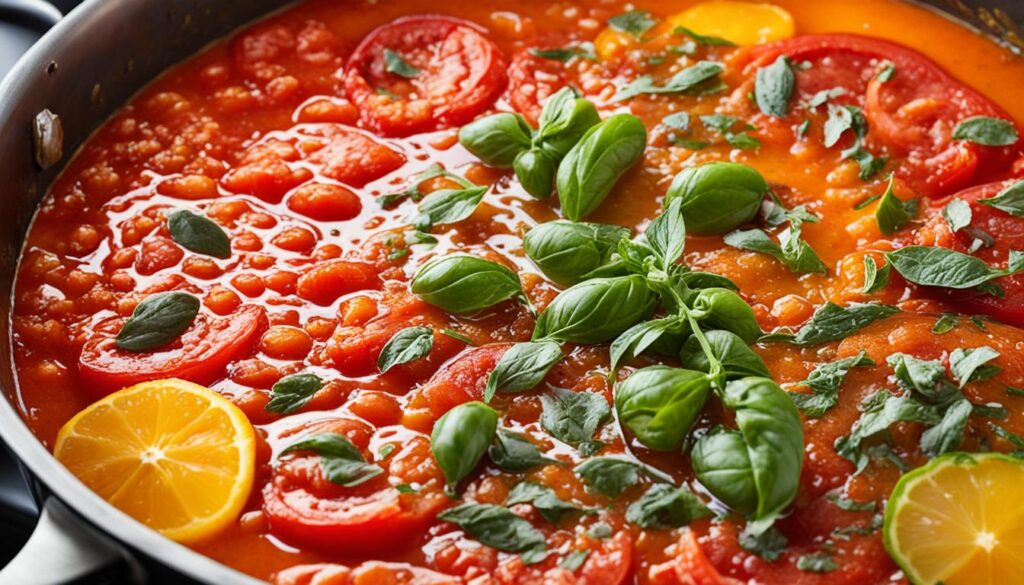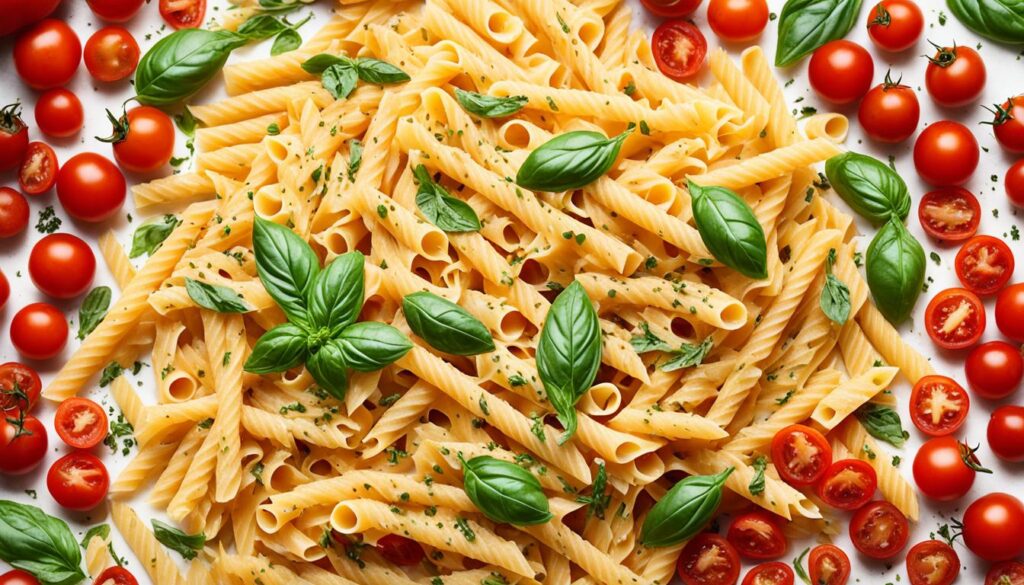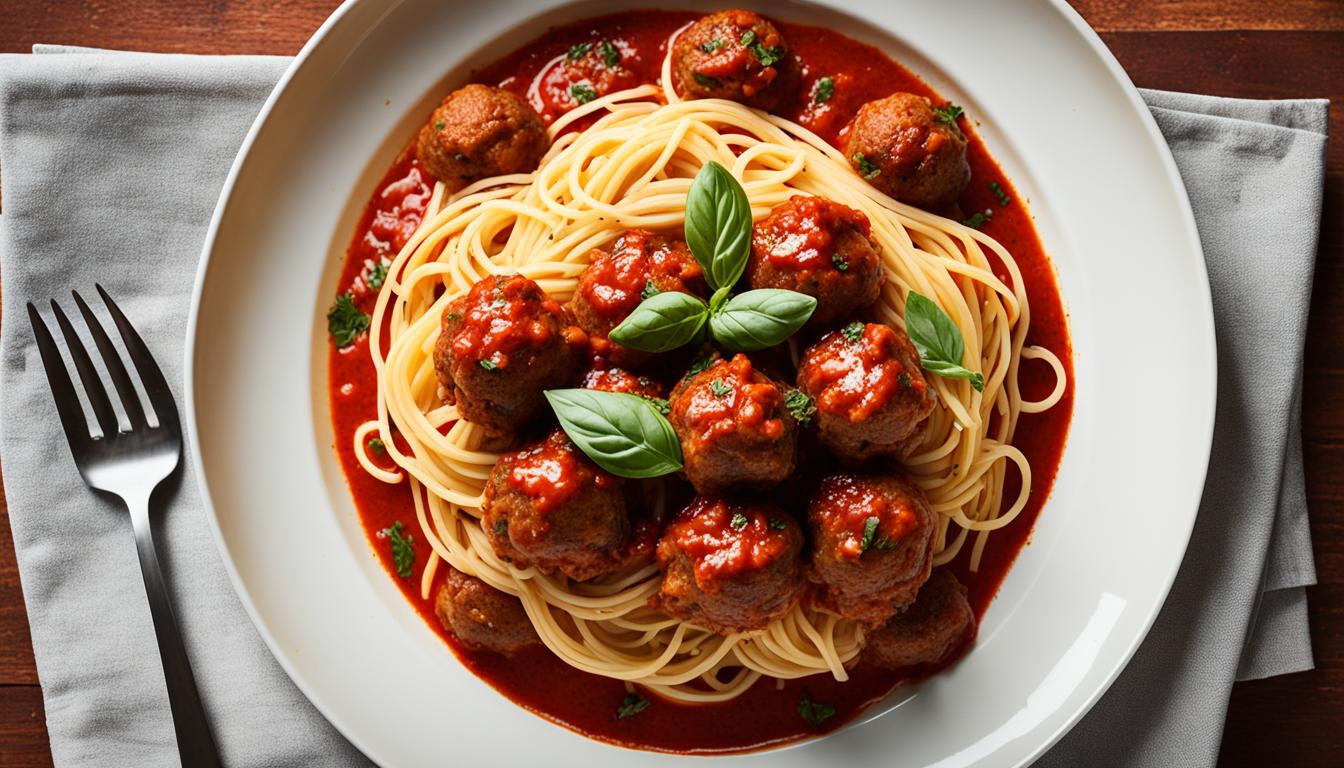When it comes to saucing pasta, we know that getting it right is essential. That’s why we’re here to share our top pasta saucing methods, so you can sauce pasta like a pro. From pre-toasting the pasta to balancing acidity with sweetness, we have all the secrets to ensure every bite is bursting with flavor.
Pre-Toasting Pasta for Enhanced Flavor
One technique that can elevate the flavor of your pasta is pre-toasting it before boiling. This method involves spreading dried pasta on a baking sheet and toasting it in the oven for a short period of time. The toasted pasta will have a slightly darker appearance and a chewier texture. Many home cooks have found this technique to prevent the pasta from becoming overdone or mushy. It’s worth trying if you want perfectly textured pasta in recipes where the pasta itself is meant to shine.
Pre-toasting pasta is a simple yet effective technique that enhances the flavor profile of your dishes. By exposing the pasta to heat before boiling, you unlock its natural flavors and create a delightful crunch. The toasting process caramelizes the starches in the pasta, resulting in a nuttier taste that adds depth to your dishes.
Not only does pre-toasting enhance the flavor of your pasta, but it also helps to maintain its al dente texture. The toasting process forms a protective barrier on the surface of the pasta, preventing it from absorbing too much water during boiling. As a result, your pasta remains firm and resilient, even when cooked with a flavorful sauce.
“Pre-toasting pasta is a game-changer in my kitchen. It adds a wonderful depth of flavor and ensures my pasta dishes are never mushy.” – Maria, home cook
When pre-toasting pasta, it’s essential to keep a close eye on it to avoid burning. The process typically takes around 10-15 minutes in a preheated oven set at 350°F (175°C). You’ll know the pasta is ready when it turns a golden brown color and emits a delightful aroma. Be sure to stir the pasta occasionally to ensure even toasting.
How to Pre-Toast Pasta:
- Spread dried pasta evenly on a baking sheet.
- Place the baking sheet in a preheated oven set at 350°F (175°C).
- Toast the pasta for 10-15 minutes, stirring occasionally until it turns golden brown.
- Remove the toasted pasta from the oven and let it cool before cooking as desired.
Pre-toasting pasta is particularly effective in recipes where the pasta plays a prominent role, such as pasta salads, stir-fries, or light olive oil-based sauces. Combined with other flavor-enhancing techniques, pre-toasting pasta can take your dishes to new heights and impress your dinner guests with its delectable taste and texture.
Balancing Acidity with Sweetness
Another important aspect of saucing pasta is balancing acidity, especially in tomato-based sauces. Tomatoes can be quite acidic, and adding sweetness can help counterbalance the acidity and create a more well-rounded flavor. While sugar is a common choice for adding sweetness, alternatives like maple syrup, agave, or honey can also work.
Start with small amounts of sugar and taste the sauce after each addition to find the perfect balance of savory and sweet.
| Sweetening Options | Characteristics |
|---|---|
| Sugar | A commonly used sweetener in tomato-based sauces, it dissolves easily and provides a neutral sweetness. |
| Maple Syrup | Offers a subtle, caramel flavor and adds a touch of richness to the sauce. |
| Agave | Provides a mild sweetness with a hint of floral flavor. |
| Honey | Brings a delicate sweetness and a touch of complexity to the sauce. |
Experiment with different sweeteners to find the one that suits your taste preferences and complements the other ingredients in your sauce.

The Essential Components of a Pasta Sauce
To create a flavorful pasta sauce, we must pay attention to the components we use. A well-balanced sauce requires careful selection and combination of key ingredients. Let’s take a closer look at the essential components that contribute to a delicious pasta sauce.
Soffritto Base
One of the foundational elements of a pasta sauce is the soffritto base. Typically made with onions or garlic, the soffritto base adds depth and complexity to the sauce. It serves as the flavor-building foundation that sets the stage for the rest of the ingredients. Sautéing the onions or garlic in oil or butter until they are softened and lightly browned enhances their natural sweetness and releases their aromatic qualities.
Tomato Selection
The choice of tomatoes plays a crucial role in determining the flavor and texture of the sauce. Whether using fresh or canned tomatoes, it’s important to select the right variety. For a sweeter, less acidic sauce, opt for vine-ripened tomatoes or San Marzano tomatoes. Their rich, complex flavors will shine through in the finished dish. Alternatively, plum tomatoes are an excellent choice for a thick and pulpy sauce.
Choice of Grease
The type of grease used in the sauce can have a significant impact on its overall flavor profile. Olive oil is a popular choice as it adds a delicate fruity taste and a pleasant mouthfeel. Alternatively, butter can lend a rich and creamy quality to the sauce. For a more robust flavor, consider using bacon fat or pancetta drippings. The grease you choose will depend on personal preference and the desired flavor profile of your sauce.

Now that we have explored the essential components of a pasta sauce, it’s time to put this knowledge into practice. By carefully selecting the soffritto base, tomatoes, and grease, you can create a sauce that tantalizes the taste buds and elevates your pasta dishes to new heights.
Cooking Pasta and Incorporating Sauce
When it comes to cooking pasta, achieving the perfect al dente texture is essential to create a satisfying dish. To accomplish this, start by boiling the pasta for the recommended time stated on the package. However, it’s important to note that the recommended time may vary depending on the type and brand of pasta you are using.
To ensure your pasta reaches the desired texture, begin testing it a couple of minutes before the recommended time. Use a fork or tongs to take a small piece of pasta and taste it. Al dente pasta is firm to the bite, offering a slightly chewy texture. If the pasta is still too firm, continue cooking and test it again in 30-second intervals until it reaches the desired doneness.
Remember: Pasta will continue to cook even after you drain it, so it’s better to slightly undercook it during boiling to achieve the perfect al dente texture.
Once your pasta is cooked to perfection, it’s time to incorporate it into the sauce. This step is crucial for achieving a cohesive and flavorsome dish. The hot pasta will absorb and meld with the flavors of the sauce, creating a delicious harmony on your plate.
Start by heating the sauce in a separate pan. Once the sauce is heated through, add the cooked pasta directly into the pan and toss it gently to ensure every strand is evenly coated. The pasta-sauce integration allows the flavors to meld together, creating a harmonious dish where each bite is bursting with taste.
Note: It’s important to ensure that the quantity of sauce is sufficient to coat the pasta adequately. If needed, add a small amount of pasta cooking water to help the sauce adhere to the pasta and prevent it from drying out.
Now that your pasta and sauce are beautifully combined, it’s time to serve and enjoy!
Adding the Finishing Touches
After all the hard work of saucing pasta, it’s time to add the finishing touches that will elevate your dish to the next level. One simple but effective way to enhance the flavor is by sprinkling grated Parmesan cheese on top. The salty and savory notes of the Parmesan complement the pasta and sauce, adding an irresistible depth of flavor.
However, taste is subjective, and personal preference plays a vital role in achieving the perfect balance of flavors. Take a moment to taste your pasta dish and make adjustments according to your liking. If you feel it needs a little extra seasoning, don’t hesitate to add more salt, pepper, or any other desired flavors.
Remember, cooking is an art, and each person has their own unique taste preferences. Whether you prefer a bolder, spicier flavor or a more mellow and balanced profile, adjusting the seasonings to your personal taste is key to creating a truly delicious pasta dish.
So, as you put the finishing touches on your sauced pasta, consider adding that sprinkle of grated Parmesan and don’t be afraid to make those personal taste adjustments. Your pasta dish will be a reflection of your culinary creativity and leave your taste buds perfectly satisfied.
